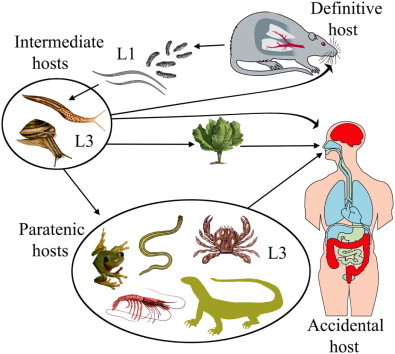Fig. 1.

The life cycle of Angiostrongylus cantonensis. Rat definitive hosts acquire third-stage larvae by ingesting infected intermediate hosts, aquatic or terrestrial snails and slugs. Larvae penetrate the stomach, enter the hepatic portal and mesenteric lymphatic systems and are carried to the heart and lungs. They enter alveoli, invade the pulmonary veins, are returned to the left heart and distributed around the body by the arterial circulation. Larvae reach the CNS, predominantly the cerebrum and cerebellum, grow and moult twice in the parenchyma and young adults invade the subarachnoid space of the brain. After about two weeks they invade the cerebral vein and move to the heart and pulmonary arteries where they mature. Eggs are carried in the blood to the lungs where they embryonate. First-stage larvae escape up the bronchial escalator, are swallowed, pass out in the faeces, are ingested by intermediate hosts, snails and slugs, and develop to third-stage infective larvae. A broad spectrum of animals – planarians, prawns, crabs, frogs and lizards may serve as paratenic hosts in which infective larvae reside but undergo no further development. Humans are an accidental host and infection may occur through ingestion of intermediate or paratenic hosts, the latter often eaten raw or their juices used in preparation of local dishes. Infective larvae may also leave molluscs and contaminate vegetables such as lettuce (adapted from Wang et al., 2008, fig. 1).
